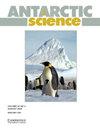Episodic basin-scale soil moisture anomalies associated with high relative humidity events in the McMurdo Dry Valleys, Antarctica
IF 2
4区 地球科学
Q3 ENVIRONMENTAL SCIENCES
引用次数: 5
Abstract
Abstract Outside of hydrologically wetted active layer soils and humidity-sensitive soil brines, low soil moisture is a limiting factor controlling biogeochemical processes in the McMurdo Dry Valleys. But anecdotal field observations suggest that episodic wetting and darkening of surface soils in the absence of snowmelt occurs during high humidity conditions. Here, I analyse long-term meteorological station data to determine whether soil-darkening episodes are present in the instrumental record and whether they are, in fact, correlated with relative humidity. A strong linear correlation is found between relative humidity and soil reflectance at the Lake Bonney long-term autonomous weather station. Soil reflectance is found to decrease annually by a median of 27.7% in response to high humidity conditions. This magnitude of darkening is consistent with soil moisture rising from typical background values of < 0.5 wt.% to 2–3 wt.%, suggesting that regional atmospheric processes may result in widespread soil moisture generation in otherwise dry surface soils. Temperature and relative humidity conditions under which darkening is observed occur for hundreds of hours per year, but are dominated by episodes occurring between midnight and 07h00 local time, suggesting that wetting events may be common, but are not widely observed during typical diel science operations.南极洲麦克默多干谷与高相对湿度事件相关的幕式盆地尺度土壤水分异常
除水文湿润的活性层土壤和湿度敏感的土壤盐水外,低土壤水分是控制麦克默多干谷生物地球化学过程的限制因素。但实地观察表明,在没有融雪的情况下,在高湿度条件下,表层土壤会出现间歇性的湿润和变暗。在这里,我分析了气象站的长期数据,以确定仪器记录中是否存在土壤变黑事件,以及它们实际上是否与相对湿度相关。邦尼湖长期自主气象站的相对湿度与土壤反射率之间存在较强的线性相关。土壤反射率在高湿条件下平均每年下降27.7%。这种变暗的幅度与土壤湿度从< 0.5 wt.%的典型背景值上升到2-3 wt.%是一致的,这表明区域大气过程可能导致在其他干燥的表层土壤中广泛产生土壤水分。在温度和相对湿度条件下,每年观测到变暗的时间为数百小时,但主要发生在当地时间午夜至7点之间,这表明变湿事件可能很常见,但在典型的实验科学操作中并未广泛观察到。
本文章由计算机程序翻译,如有差异,请以英文原文为准。
求助全文
约1分钟内获得全文
求助全文
来源期刊

Antarctic Science
地学-地球科学综合
CiteScore
3.60
自引率
6.20%
发文量
42
审稿时长
3 months
期刊介绍:
Antarctic Science provides a truly international forum for the broad spread of studies that increasingly characterise scientific research in the Antarctic. Whilst emphasising interdisciplinary work, the journal publishes papers from environmental management to biodiversity, from volcanoes to icebergs, and from oceanography to the upper atmosphere. No other journal covers such a wide range of Antarctic scientific studies. The journal attracts papers from all countries currently undertaking Antarctic research. It publishes both review and data papers with no limits on length, two-page short notes on technical developments and recent discoveries, and book reviews. These, together with an editorial discussing broader aspects of science, provide a rich and varied mixture of items to interest researchers in all areas of science. There are no page charges, or charges for colour, to authors publishing in the Journal. One issue each year is normally devoted to a specific theme or papers from a major meeting.
 求助内容:
求助内容: 应助结果提醒方式:
应助结果提醒方式:


